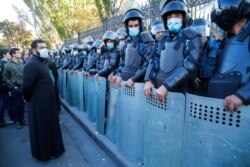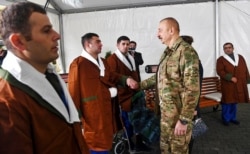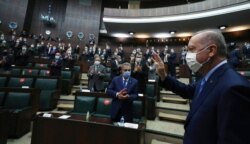Armenia’s opposition parties have reacted with fury to a Kremlin-brokered cease-fire aimed at ending weeks of fighting with Azerbaijan over the breakaway region of Nagorno-Karabakh.
For a second day Wednesday, thousands of the parties' supporters defied a pandemic-related ban on street rallies to protest in the capital, Yerevan, against a truce they see as an abject surrender. Under the agreement, several areas were ceded to Azerbaijan, which had gained a critical military advantage.
On Tuesday, protesters stormed and ransacked some government buildings in Yerevan to vent their anger over the cease-fire in Nagorno-Karabakh, an enclave that is internationally recognized as part of Azerbaijan but is governed by ethnic Armenians with the backing of Yerevan.
After six weeks of intense fighting, Armenian Prime Minister Nikol Pashinyan announced the truce Tuesday on his Facebook page, dubbing it a “painful” settlement.
“This is a big failure and disaster,” he said Tuesday.
Pashinyan said he took personal responsibility for the setbacks, but added he concluded the deal under pressure from army chiefs who feared that without it, Azerbaijan might seize the whole enclave.
Pushback from protesters
The mountainous enclave had not seen such heavy clashes since the early 1990s, when as many as 30,000 people were killed before a cease-fire, largely orchestrated by Russia and with the backing of the United States and France, left the dispute frozen.
Subsequent negotiations to conclude a lasting political settlement have stalled for years, to growing frustration, mainly in Azerbaijan. The decades-long conflict has seen periodic flare-ups followed by resentful truces.
Many of the protesters in Yerevan's Freedom Square chanted, “Nikol is a traitor,” condemning his acceptance of the deal that allows Azerbaijan to keep areas it captured.
According to local Armenian media reports, about 80 people were detained during the Yerevan protests, including Gagik Tsarukyan, leader of Prosperous Armenia, the country's second-biggest party. Parliamentary speaker Ararat Mirzoyan was beaten unconscious by furious protesters.
Pashinyan took office after heading a peaceful 2018 revolution in the post-Soviet state. Some analysts and Western diplomats say he's likely to struggle to remain in power, an outcome that would likely not displease the Kremlin, depending on who replaces him.
Before the 2018 Velvet Revolution, Pashinyan criticized Armenia’s dependence on Russia, complaining the Kremlin had taken advantage of the country. In power, however, he has kept to a careful line, reassuring the Kremlin that Armenia remains a close geopolitical ally, while including in his government those with openly pro-Western sympathies, some of whom worked previously for U.S.- and European-funded NGOs.
Yulia Latynina, a commentator for Russia’s Novaya Gazeta newspaper, said Russia waited until Nagorno-Karabakh was on the brink of total defeat before brokering a truce because the Kremlin wanted to make the settlement as costly as possible for Pashinyan.
The Kremlin says the cease-fire deal is “a victory for the peoples of two countries, Azerbaijan and Armenia.” While angry mobs protested in the streets of the Armenian capital, celebrations broke out in Azerbaijan. In a national address, Azeri President Ilham Aliyev described the truce as Armenia’s military surrender.
Russia in the middle
Russia has largely maintained a balancing act with its two troublesome southern neighbors. Moscow has a formal mutual defense pact with Armenia and operates an air base there but enjoys close ties with Baku as well. It has supplied both Armenia and Azerbaijan with arms, an evenhanded approach aimed at keeping both Baku and Yerevan within Russia’s sphere of influence. The so-called frozen conflict served Russia’s purposes, say analysts. Moscow avoided intervening militarily in the past six weeks.
The geopolitical equilibrium Russia crafted was shattered by the latest flare-up in Nagorno-Karabakh, partly as a result of the involvement of Turkey, which supplied armed drones and fighters to Baku, adding a new layer of complexity to the ancestral feud.
Russian state-controlled media have portrayed the Nagorno-Karabakh cease-fire as a battlefield victory for Azerbaijan, but a diplomatic win for President Vladimir Putin. Many commentators say the Kremlin managed to save the Armenian-ruled enclave from being overrun by Azeri forces while pressuring Baku to pull up short on its war aim of taking back Nagorno-Karabakh in its entirety.
Michael Lambert of the Russian International Affairs Council, a research group based in Moscow and funded by the Russian government, likened the deal to “the Judgment of Solomon, in which King Solomon of Israel ruled between two women both claiming to be the mother of a child.”
He added in a commentary, “Solomon revealed their true feelings and relationship to the child by suggesting the baby be cut in two, each woman to receive half.”
“It is a catastrophic defeat for Armenia and a big success for Azerbaijan,” said Robert Cutler of the Canadian Global Affairs Institute, a research organization based in Calgary and Ottawa.
“Pashinyan led the country into a catastrophe. When he first came into power, he met with Azerbaijan’s Ilham Aliyev and said, ‘Give me time.’ But because of domestic Armenian domestic politics, he became more nationalist,” said Cutler. “In the long run, I think it is difficult. It is remarkable he has survived since Tuesday.”
Cutler said Pashinyan is relying on Arayik Harutyunyan, leader of the Nagorno-Karabakh government, to provide cover for his decision to accept the deal.
The enclave’s Armenian leader has so far supported Armenia’s prime minister, saying at midweek that the cease-fire was necessary to prevent further loss of life and territory.
“If the fighting had continued, we would have lost the whole of Artsakh within a few days, and we would have had more victims,” he said. Artsakh is the Armenian name for Nagorno-Karabakh.
“Events are taking charge. We will have to see,” Cutler added.
Cease-fire agreement
Under the terms of the cease-fire, Russia is to deploy 2,000 troops as peacekeepers. Russian state media broadcast footage of Russia’s 15th Motorized Rifle Brigade heading to Nagorno-Karabakh. The cease-fire stipulates a prisoner exchange and transfer of bodies. The agreement also requires Armenia to give up some contested areas it held outside the borders of the contested enclave.
Since Azerbaijan, backed by Turkey, launched an offensive in September, thousands of people, including civilians, have been killed and more than 100,000 displaced.
Some analysts say while the truce is likely to hold and end the bloodletting, it will do little to resolve the conflict in the long term. One big question is the future role of Turkey in the region, which intervened in an area Moscow considers its sphere of influence. Turkey’s role was decisive, say military observers, with the drones it supplied wiping out Armenian armored units.
Moscow moved quickly to rebut a statement by Azeri President Aliyev that Turkey would also deploy peacekeepers to Nagorno-Karabakh as part of a joint peacekeeping mission.
“The deployment of Turkish soldiers in Karabakh has not been agreed on,” Dmitry Peskov, Putin’s spokesman, said Tuesday.
The text of the agreement as published by the Kremlin makes no mention of Turkish peacekeepers.
Aliyev said in his national address that Turkish peacekeepers would play a role.
“There will be a joint peacekeeping mission by Russia and Turkey. It’s a new format,” Aliyev said in his speech Tuesday.
Alexander Rahr, a Russian foreign policy expert, told the newspaper Nezavisimaya Gazeta the truce provides an opportunity for Russia to build better ties with Turkey. But he acknowledged that Moscow has “allowed Ankara into the Caucasus.”












